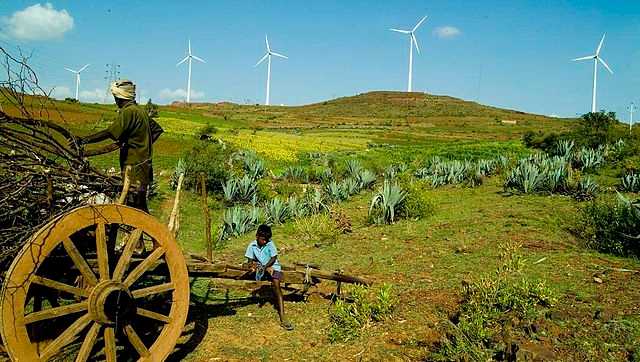Union Budget 2022-23: Despite a sharper focus on renewable energy and India’s significant potential, offshore wind power has not yet been popularised

Indian Union Budget 2022: Field and wind turbines in India. Vestas/Wikimedia Commons
If there is a clarion call emanating from the COVID-19 pandemic, it is that India should aim for a greener recovery and accelerate towards net-zero emissions. This is critical to secure a sustainable future and offsetting the adverse impact of climate change. While this warrants fiscal support to fund clean technologies, the cost of not transitioning is way more.
The Union Budget for 2022-23 can pave the path through a series of steps.
Support cleantech through R&D
The first is to create a war-chest to support clean technologies through research and development (R&D), tax and duty concessions, capital grants, and demonstration projects. The government can also undertake direct procurement of such clean technologies.
The fund can be capitalised through budgetary allocation and leveraged via sovereign green or sustainability bonds. Such external borrowings by the government can rein in costs and will also showcase India’s efforts to fight climate change and ensure sustainable growth.
Kickstart hydrogen revolution
The government can sharpen focus on green hydrogen, where the CO2 abatement potential is high owing to its broad-based applications across energy use, industrial processes, transport, and agriculture.
A combination of long-term consumption mandates for identified end-users (such as refineries, fertiliser factories, and city gas distribution) to ensure offtake and supply-side incentives such as reduction in customs duty on electrolyser imports, land and power at concessional rates and viability gap funding (VGF) (linked to production and efficiency) can help kickstart India’s hydrogen revolution.
In this context, tax breaks for hydrogen transport and storage infrastructure make sense. Setting up a nodal agency to coordinate with line ministries and aggregate demand across end-users can accelerate deployment.
Popularise offshore wind power
Despite a sharper focus on renewable energy (RE) and India’s significant potential, offshore wind power has not yet been popularised. Given the 500 GW non-fossil fuel target by 2030, offshore wind power will become increasingly critical owing to the land intensity of RE projects.
Promoting demonstration projects through upstream oil and gas majors and independent power producers could be a start. In parallel, single-window clearance, including leasing of the seabed, phased VGF and separate offtake targets for distribution companies would facilitate capacity additions.
Power EV charging, battery swapping station with RE
Powering electric vehicle charging and battery swapping stations using RE would help the green cause. Operators can be offered tax breaks on infrastructure rollout and allowed to source RE through open access at concessional charges irrespective of the connection size.
Roadmap needed to support indigenous battery manufacture
As large-scale RE plugs into the grid, energy storage would play an important part. That means a long-term roadmap is essential to support indigenous battery manufacturing. This can be done by investing in R&D through the energy transition fund, leveraging government to government relations for raw material supply and technology transfer, extending tax concessions, and ensuring adequate funding to the Production-Linked Incentive scheme.
Encouraging battery-based project operations through incentives for off-peak storage, higher payouts to fast-responding storage systems, and strong payment security would also encourage the ecosystem.
Invest in smart grids
Investing in smart grids is critical to fuel RE integration, and reduce aggregate technical and commercial losses in distribution. Adequate budgeting under the Smart Grid Mission, in addition to the outlay planned as part of the Revamped Distribution Scheme for the installation of smart meters, is essential.
Control carbon emissions by levying tax
In sectors with constrained CO2 abatement potential, such as steel, cement and other heavy industries, carbon capture will be critical to control emissions. Capital grants can be provided to promote carbon capture, utilisation, and storage (CCUS) projects by levying tax on carbon emitted by industries above a certain benchmark.
Identifying clusters in sectors such as chemicals and cement for setting up pilot projects to not only capture, but also utilise it would produce more sustainable products. Public procurement of such low-CO2 products could also support CCUS projects. Thrust could also be placed on integrated oil and gas majors to capture carbon from refineries and use it to enhance recovery from depleted fields.
Assign GEC in accordance with green expenditure
India, like France, can gradually move towards assigning a green energy coefficient (GEC) to each budget line in accordance with the green expenditure relative to environmental priorities.
Clear prioritization among the above-highlighted technologies along with some initiation measures, at least, are critical to progress towards meeting our long-term global commitments.
The author is Director- Energy and Natural Resources, CRISIL Risk and Infrastructure Solutions. Views are personal.
Read all the Latest News, Trending News, Cricket News, Bollywood News,
India News and Entertainment News here. Follow us on Facebook, Twitter and Instagram.

)





More News
Did Congress Give Reservation To Muslims Under OBC Quota In Karnataka As Claimed By PM Modi?
BJP intensifies ‘Muslim quota’ attack on Congress, cites Manmohan Singh’s 2019 remarks | India News – Times of India
Congress Announces Heavyweights For Haryana Lok Sabha Election: Selja Vs Tanwar In Sirsa, Hooda For Rohtak